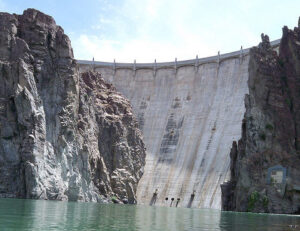Last month, the White House released a $1.5 trillion infrastructure plan that calls for $200 billion in federal infrastructure spending, with the rest coming from state and local governments and private investment. Because of the plan’s reliance on states to develop projects, it’s an opportunity for states and environmentalists to use federalism to steer projects in an environmentally friendly direction.
The proposal will require legislation to implement, so who knows whether it will move forward. But with that huge qualification, the plan has several elements that could empower environmentalists and states generally opposed to the Trump administration to prove that development can be good for both people and the environment.
Under the proposal, half of the federal money go to grants to states and local governments, with projects judged based on their costs and proof of non-federal funding sources to contribute to the costs and provide long-term maintenance. To the extent infrastructure projects that incorporate natural elements are lower-cost, or can be made so through outside support from environmentalists, such projects would have a competitive advantage under the plan.
The Nature Conservancy (which has criticized the plan for not requiring nature to be incorporated into infrastructure developments) has long advocated such incorporation to lower costs and provide additional benefits. For instance, they argue that natural flood control systems, like wetland restoration, are cheaper and more effective than digging more concrete flood control channels.
The plan’s federalism element presents an opportunity to prove that case. If a handful of states can be convinced to try incorporating natural elements into their flood, their experiments could show the rest that this approach is better both for the environment and reducing costs. They would act as the “laboratories of democracy” that nudge their neighbors to follow suit. We’re already seeing that play out as many states react to the Trump administration’s environmental policies by developing their own state-based policies to fill the gaps. Why wouldn’t California and New York also seize the opportunity to steer the infrastructure plan in an environmentally friendlier direction, at least within their states?
By recommending expedited environmental review for projects that provide environmental restoration, the infrastructure plan reinforces that incentive by encouraging projects to incorporate additional environmental benefits. For instance, several recent natural gas pipeline projects have incorporated enhanced habitat along their routes. The Atlantic Coast Pipeline Pollinator Habitat Initiative, for instance, will provide 750 acres of habitat for butterflies, bees, and other pollinators:
In developing the program, the project consulted with a number of wildlife experts, including Bob Glennon, a private lands biologist for Virginia Tech’s Conservation Management Institute. “By replanting the pipeline right of way with pollinator habitats, as opposed to mowed grasses, we’ll be creating hundreds of acres of new habitat for these species that we otherwise wouldn’t have,” said Glennon. “I couldn’t think of a more environmentally beneficial use of these spaces, and I’m very proud to be a part of it.”
One of the participating landowners is Ward Burton, founder and president of the Ward Burton Wildlife Foundation. Two of the Foundation’s parcels are crossed by the pipeline in southern Virginia and have been selected for the initiative. “As a lifelong conservationist, I couldn’t be more excited to participate in this program,” said Burton. “Not only will it be beneficial for the pollinators, but it’s also going to create new habitats for other wildlife like quail, turkey and songbirds. I see this as a really creative way to not just restore the right of way, but actually enhance its environmental value beyond what it was when we started.”
Under the infrastructure plan, such efforts will be rewarded by reducing permitting delays, something we should all cheer. But we’ll have to wait and see what, if anything, comes from the plan, as well as whether states and environmentalists seize the opportunity.




